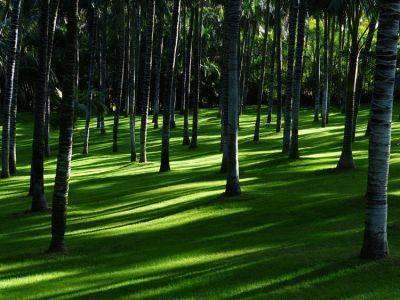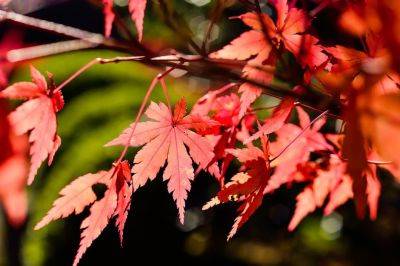Information pertaining to broadleaf trees. Listed below are common trees with care facts.
Why we plant a trees
22.01.2024 - 21:21 / backyardgardener.com / Frederick Leeth
We plant trees for their beauty of leaf, whether green in Summer or red in the Autumn; for their bark which becomes particularly fascinating. We plant trees because we love them. Some trees linger in our memories as old friends, from whose branches we have swung and “skinned-the-cat”; under whose cool shade we have rested from play or work. Some trees seem to have moods, changing from day to day, season to season, and from youth to old age.
In Winter; for the delicate tracery of the branches which frame our view of the eternal blue or star-scattered heavens; for their flowers which seem like giant nosegays.
We plant trees to shelter our homes from the Summer sun and from the cold sweeping winds of Winter.
We enjoy a touch of Nature to form a background and a frame for our architecture.
We plant trees to furnish leaf cloisters for the birds which awaken us from our too-late slumbers when all the world of Nature, except ourselves, is awake.
We plant trees because, where they expand their verdant branches the air is purer and less dusty. The medical societies are constantly advocating the planting of city trees to temper the heat of Summer on the torrid pavements.
We plant forests that floods may be prevented; that fertile soil shall not be carried to the valleys below; that rainfall may be regulated.
We plant trees for their economic use-lumber, furniture, turpentine, rubber, quinine, nuts, cork, paper, windbreaks, and one thousand and one uses for which we have as yet found no substitute.
We plant avenues of trees in cities and along the roadsides, because we believe that no road or street is dressed or finished until it has been planted to furnish shade, frame vistas of outlying beauty, and prevent snowdrifts.
Aside from this

Installing Proper Garden Drainage for Garden Plants
One of the greatest drawbacks to successful gardening is badly drained ground. Wherever water lies in the ground at a depth easily reached by the roots of most cultivated plants they do not thrive, except where the water is constantly on the move, such as the bank of a river, brook or lake; there many plants will flourish. There are some wild plants that succeed in soil that has reached a water logged state, but generally such land is useless for gardening, farming or forestry purposes unless steps are taken to free it from superfluous moisture.

Shade Trees How to Select and Care for Them
Trees for shade should be planted only after thoughtful selection, for those that may be very suitable in June may be less so in August. The Linden and the Mulberry are delightful trees when they come into leaf, but in July and August the former may make everything near by dirty with dripping honeydew, and in August and September falling Mulberries stain almost everything with which they come in contact.

What’s in a Plant Name?
A few weeks ago, I went to the garden center to buy some pansies to put in decorative pots by my front porch. In my experience, pansies hold up even after the mums bite the dust, and they provide color just about as long as anyone has a right to expect color from a garden plant.

Growing Guidance for Salvia Plant
From the Latin salveo, meaning save or heal, used by Pliny with reference to the medicinal qualities of some species (Labiatae). A large genus of over 700 species of hardy, half-hardy and tender annual, biennial, perennial plants and shrubs, some with aromatic leaves, widely distributed in the temperate and warmer zones. It includes the common sage, S. officinalis, a valuable culinary plant, as well as many colourful summer and autumn flowering border plants.

Trees with Red and Purple Foliage
Placing trees of these colors needs great care, but their colors mingled with the multitude of others in autumn are effective and of great beauty; they do not blend well with the normal greens, particularly if used in quantity. They should, therefore, be used sparingly in isolation at points where they will inevitably catch the eye.

Growing Guide for Bergenia Plant
Named for Karl August von Bergen, 1704-60, German botanist (Saxifragaceae). These hardy perennial herbaceous plants with large evergreen leaves were at one time called megasea, and were at another time included with the saxifrages. The flowers which come in early spring are showy in white, pink or red-purple, borne in large heads on long stems. The large leathery, glossy leaves are also decorative, especially as in some kinds the foliage is suffused with reddish color in winter.

How to plant a bean plant
These were certainly known to the Ancient Egyptians and are probably natives of northern and western Asia. They are extremely hardy.

Selecting the Correct Tree to Plant
Planting a tree takes a lot of thought. We may have to consider if we want a tree that is:

Growing Guide for Echinops – Perennial Plant
From the Greek echinos, a hedgehog, opsis, like, referring to the spiky appearance of the flower heads which resemble a rolled-up hedgehog (Compositae).

Grow Japanese Red Maple Trees from Seed
Japanese Maple seeds have a very hard outer coating as do many ornamental plants. Under natural conditions, the seeds would have to be on the ground for almost two years before they would germinate. All that happens the first winter is the moisture softens the hard outer shell, and the second winter germination begins to take place. For all of this to happen in the proper sequence so the seedlings sprout at a time of the year when freezing temperatures or hot summer sun doesn’t kill them, takes a tremendous amount of luck. You can improve the odds by controlling some of these conditions, and shorten the cycle.

Why don’t my plants flower?
Why don’t my plants flower? Probably this plaintive question is raised oftener than any other that has to do with gardening. As likely as not, too, the complaining gardener will go on to say that he gives considerable attention to fertilization, to watering, and to cultivation, but still, his plants do not flower as well as those in his neighbor’s garden. Why? he asks, and if his morale is low enough he will probably repeat, with emphasis, Why?
